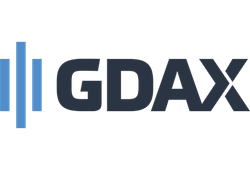
Free Airdrop Season 7 is LIVE! Answer fun questions or do simple tasks to earn rewards from the $30K BitDegree prize pool. Participate Now ! 🔥
Hi there, cryptocurrency fans! So you’re looking to make your first million trading cryptocurrencies, but first, want to know if GDAX is just as good as other recommenced cryptocurrency exchange platforms, such as Kucoin, Binance, and Kraken?
Not to worry — I’ve got everything covered! The cryptocurrency trading markets are now a multi-billion dollar industry, and during its all-time highs in December 2017, daily trading volumes were as high as the New York Stock Exchange!
In my GDAX review, I am going to answer things like ‘Is GDAX user-friendly?’, ‘What are the GDAX fees charged’? and ‘Is GDAX safe?’.
I am even going to show you how to use GDAX with some really useful screenshots! You’ve got a lot to learn, so let’s get started by finding out what is GDAX!
Pros
- Secure
- Easy to use
- Low trading fees
Cons
- Unhelpful customer support
- No anonymous trading
Table of Contents
- 1. What is GDAX? (Coinbase Pro)
- 2. GDAX is Now Coinbase Pro!?
- 3. Payment Methods and Fees
- 4. Which Coins Can you Buy on GDAX (Coinbase Pro)?
- 5. Is it Easy to Sign Up?
- 6. GDAX Customer Support
- 7. Is GDAX Safe?
- 8. Who Should Use GDAX?
- 9. The Advantages and Disadvantages
- 10. How to use GDAX: Testing the Interface
- 10.1. Finding a Trading Pair
- 10.2. Understanding the Trading Screen
- 10.3. How to Trade on GDAX
- 11. GDAX Review: Conclusion
What is GDAX? (Coinbase Pro)
GDAX is a cryptocurrency exchange that allows people to buy, sell and trade a range of digital coins. Launched in 2016, GDAX stands for Global Digital Asset Exchange. The people that created GDAX are part of the same company that runs Coinbase, which is now one of the largest exchange brokers in the world!
Essentially, the platform is a middleman between buyers and sellers and in return — GDAX makes their money by charging transaction fees. For example, if John wants to buy some Bitcoin and Jenny wants to sell, they are both matched by the GDAX exchange!

The founders wanted to provide their 13 million Coinbase users with a more advanced trading platform. The reason for this is that Coinbase only allows you to buy and sell cryptocurrencies. On the other hand, GDAX allows you to trade them in real-time, using a variety of different trading tools.
Although GDAX is looking to target the more experienced trader, it is still possible to use real-world payment methods such as a bank account to deposit and withdraw funds!
The great thing is that if you have a Coinbase account, you automatically have a GDAX account too! All you need to do is enter the same login details that you use at Coinbase!
Just like Coinbase, GDAX now has one of the largest trading volumes in the cryptocurrency industry. At the time of writing in July 2018, the exchange averages about $100 million in daily trades. The most that have ever been traded at GDAX is $650 million in a single day, which it achieved in late 2017!
So now that you know what is GDAX and how they got started, the next part of my GDAX review is going to talk about their recent rebranding to Coinbase Pro!
GDAX is Now Coinbase Pro!?
GDAX announced in May 2018 that is was going to rebrand the exchange to ‘Coinbase Pro’! Coinbase Pro will have all of the same benefits as GDAX, however, the team has added a few new features to make it even better!
The new platform is now live, meaning that if you try to access GDAX, you will be redirected to the new Coinbase Pro website. When I tested it out for the first time, I noticed a few differences.
Firstly, the platform is much cleaner, meaning that it is easier to navigate. The deposit and withdrawal process is also more straightforward, which is great! I also noticed that the pricing charts offer more options, which makes it much easier to view historical data.
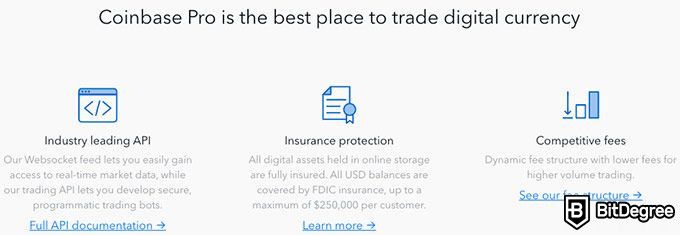
Finally, the old platform made it slightly difficult to view your portfolio of coins, but this has been changed to make it much more user-friendly!
During the announcement, GDAX also revealed that they had taken over a company called Paradex. The technology that Paradex has built will allow Coinbase and GDAX users to transfer ERC-20 token between wallets. Don’t forget, an ERC-20 token is a cryptocurrency that has been built on top of the Ethereum blockchain, and in total, there are thousands of them!
Just to let you know, I will still refer to Coinbase Pro as GDAX for the rest of my review, as I don’t want to confuse you!
So, now that you know about the Coinbase Pro rebrand, the next part of my GDAX review is going to look at what payment methods you can use and the fees that the exchange charges!

Did you know?
All Crypto Exchanges may look similar to you but they're NOT all the same!
Payment Methods and Fees
The GDAX team recognized the importance of allowing people to deposit and withdraw using real-world money, which means that you can use your bank to fund your account!
Before I discuss the fees, I wanted to make it clear that only certain countries are allowed to use a bank account to deposit. Furthermore, the type of payment system will depend on the country you are located in.
If you are located in Europe, you will need to use SEPA. GDAX does not charge a fee for this, which is great! The GDAX withdrawal fee for SEPA is only €0.15!
If you are located in the U.S., you can deposit using a U.S bank account, which will cost 1.49% of the total transaction.
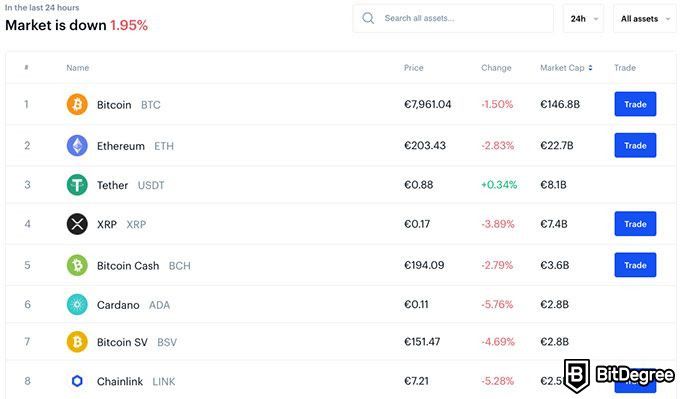
The GDAX withdrawal fee when using a U.S. bank account is also 1.49%. Alternatively, U.S. customers can do a wire transfer, which will cost a fixed-fee of $10 to deposit and $25 to withdraw.
If you are based in Canada, Singapore or Australia, you can still use real-world money to deposit funds into your GDAX account, however, at the moment, you cannot withdraw them out. This means that you will need to convert any fiat currency balances you have into cryptocurrency, and then withdraw the cryptocurrency back to your wallet.
It is also possible to transfer funds from your Coinbase balance over to your GDAX account. This is free of charge and only takes a few seconds! For a detailed guide on how to do this, you can check out this detailed tutorial!
If you are looking to deposit using a debit or credit card, GDAX does not support this directly, however, you can do this within the Coinbase platform. The charge for this is 3.99% of the total transaction amount and once you have done it, simply transfer the funds across to GDAX.
If none of these options suit you, you can also deposit using a cryptocurrency! Although GDAX won’t charge you for this, you will still need to pay the blockchain transaction fee. However, this is usually less than a dollar and will depend on what coin you choose to deposit with. The GDAX withdrawal fees for cryptocurrencies are the same as those charged for depositing, which is nothing!
When it comes to trading fees, GDAX is much cheaper than Coinbase, which charges 1.49% every time you buy or sell! GDAX fees depend on a couple of different things, which I will explain below.
Firstly, GDAX has a different rate for ‘Market Makers’ and ‘Market Takers’. The market maker is the person that provides liquidity for the exchange. Essentially, if the trader places an order at a price higher or lower than the current market price, then they are a maker.
For example, if the current price of Bitcoin on GDAX is $6,800, but you place an order to buy it at $6,300, then you are a market maker because your funds are unavailable until the order is executed. This is important for cryptocurrency exchanges because it ensures there is enough liquidity for other traders.
As a result, GDAX does not charge any trading fees for market ‘makers’! On the other hand, if a trader buys or sells a coin at the current market price offered by the exchange, then they are a market ‘taker’!
The fees charged for market takers depend on how much you trade in a single month. The highest fee charged is just 0.30% of the total trade amount. If you trade more than $10 million then this is reduced to 0.20% and if you are crazy enough to trade more than $100 million, this is reduced to 0.10%!

So now that you know about the GDAX payment methods and fees, the next part of my GDAX review is going to look at what coins you can buy!
Which Coins Can you Buy on GDAX (Coinbase Pro)?
One of the most disappointing aspects of using GDAX is that the number of coins available to buy, sell and trade is really limited. In fact, at the time of writing in July 2018, the exchange only supports four cryptocurrencies.
These are Bitcoin (BTC), Ethereum (ETH), Litecoin (LTC) and Bitcoin Cash (BCH), which is the same as Coinbase. According to the Coinbase and GDAX team, the exchanges hope to start supporting more coins very shortly.
Dan Romero, who is the general manager at Coinbase, recently explained that adding more cryptocurrencies is a top priority, however, they are taking their time due to U.S. regulations. However, what we do know is that Ethereum Classic (ETC) will soon become the fifth coin to be supported on GDAX, which is expected to happen in the second half of 2018!
Cryptocurrency projects are keen to have their coin listed on Coinbase and GDAX because they have more than 13 million customers and the platforms make it easy to use real-world money.
For example, the team behind Ripple (XRP) has been trying to get their coin listed on Coinbase and GDAX for a long time now, with the team even offering to lend the platforms $100 million worth of XRP! When rumors were released that the deal was going to go through, the value of XRP went crazy! However, once it was revealed that Ripple wasn’t going to be added, its value dropped back down!

|
|
|---|---|
| Advanced Users & Beginners | |
| Turkey, Argentina, Vietnam, Ukraine, + 180 more | |
| See All Coupons of Best Exchanges | |
| One of the leading crypto exchange platforms in the industry. | |
|
See TOP10 Brands
Read review |
Table: Information about the general features of the Binance exchange
In reality, if you are looking for an exchange that supports lots of different cryptocurrencies, then GDAX might not suit you. There are other exchanges, such as Binance, that list hundreds of different coins, with more being added all the time.
Just to let you know, it is also possible to trade the four supported coins against fiat currencies such as USD and EUR, which is a cool feature!
So now that you know what coins the exchange supports, the next part of my GDAX review is going to look at the signup process!
Is it Easy to Sign Up?
You might remember how I mentioned earlier that if you already have a Coinbase account, you automatically have a GDAX account. If this is the case, you can move to the next part of my GDAX review!
If not, let me quickly explain the sign-up process, which is the same for both Coinbase and GDAX.

As the platform is based in the U.S., they take account security very seriously. This means that, unlike some exchanges, you will not be able to trade anonymously. As a result, you will need to go through a KYC (Know Your Customer) process. But don’t worry, it’s really simple and only takes a few minutes!
Firstly, you will need to supply the exchange with a range of personal details. This will include your name, nationality and full address. After this, you will then need to upload some identification to prove your identity, such as a passport or driving license.
The good thing is that the document verification is automated, meaning that the system can confirm your identity without needing a GDAX employee to do it manually! When I went through the process, it only took me 10 minutes, in total!
As soon as you have done this, you can then link your debit/credit card or bank account and make a deposit straight away!
Just remember that if you want to withdraw more than $10,000 in a single day, you will need to provide the exchange with additional information. This depends on where you are based and could include a phone verification or a request for proof of address (like a bank statement).
So now that you know about the simple sign-up process, the next part of my GDAX review is going to look at the exchange’s customer support!
GDAX Customer Support
When I am thinking about using a cryptocurrency exchange for the first time, one of the most important things I look for is what customer support is available. If a thing goes wrong, I want to know that I can receive fast and efficient help, which is why I have decided to cover it in my GDAX review!
Customer support at GDAX is one of the best in the industry! Firstly, the GDAX customer service team can be reached by telephone. This service is available Monday-Friday, between 8 A.M. and 5 P.M (Pacific Time).
If you need to contact the team outside of these hours, you can send them an email 24 hours a day. Alternatively, you can also contact GDAX on various social media channels such as Twitter. If you decide to go this route, just be sure that you don’t post any sensitive account details!
The only negative aspect to the GDAX customer service team is that they don’t have a live chat facility. However overall, if you have any issues with your account, the GDAX team are usually very quick to respond!
So now that you know about customer support, the next part of my GDAX review is going to find out is GDAX safe!
Is GDAX Safe?
As GDAX and Coinbase are both owned by the same company, they both use the same security controls. I mentioned earlier that every GDAX user must identify themselves before they can start trading, which means that any fraudulent activity can be traced directly to the individual.
GDAX is responsible for hundreds of millions of dollars’ worth of cryptocurrency, so they have to make sure they keep customer funds safe. 98% of all funds are kept in cold storage, meaning that they are always held offline. This makes it practically impossible for an online hacker to access them!
Coinbase stores 98% of customer funds this way, the remaining are insured. We encourage all exchanges to employ these security measures.
— Coinbase Pro (@CoinbasePro) 3 August 2016
The remaining 2% of funds are held online, which allows the exchange to process customer orders. GDAX offers its users the option of setting up two-factor authentication (2FA). Once you have a 2FA set up, you will need to enter a unique code that is sent to your mobile phone, every time you want to log in.
GDAX has also installed a really good security feature called the ‘Vault’. If you decide to store your coins in the vault, the funds are not released until 48 hours after your withdrawal request. This acts as an extra level of security because if a hacker gained access to your account, you would have 48 hours to cancel the transaction.
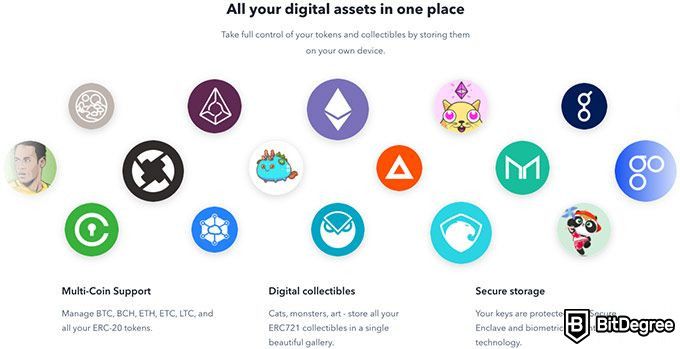
GDAX also offers something called multi-approval. This is where more than one person is required to confirm a withdrawal request. This is a fantastic security feature as it makes it practically impossible for anybody to steal your funds! For example, if you used somebody you trusted as the second approver, nobody could withdraw your funds until both of you confirm it!
An additional security feature at GDAX is their FDIC agreement. This means that if Coinbase had their funds hacked or the company went out of business, your funds would be protected up to $250,000! Just remember, though - to be protected by the FDIC, your funds need to be held in your GDAX USD wallet.
Everything sounds too good to be true, right? Well, there was a slight issue that I wanted to talk to you about! On June 21st, 2018, the price of Ethereum on GDAX suddenly went down from $319 to $0.10! The reason for this is that a trader sold millions of dollars' worth of ETH, which, for a few seconds, resulted in a price crash.
This meant that some traders lost a lot of money as the price drop activated various orders. Some people think that this was an attempt to manipulate the market, however, this is yet to be proven. Nevertheless, if anybody was lucky enough to spend $380 on ETH when it temporarily went down to 10 cents, when the price went back up, their investment would have been worth more than $1 million!
Other than this one-off event, GDAX is one of the most secure exchanges in the industry.
So now that you know is GDAX safe, the next part of my GDAX review is going to look at who the exchange is suitable for!
Who Should Use GDAX?
The GDAX platform is slightly more complex than Coinbase because it actually allows users to trade cryptocurrencies, rather than just buy and sell them. This means that you will need a little bit of experience on how cryptocurrency exchanges work.
The markets are volatile and prices can rise or fall quickly, so I will just make sure that you understand some of the key features. The cryptocurrencies that you want to trade are called ‘Pairings’. For example, if you want to trade Bitcoin with Ethereum, then you will need to access the BTC/ETH pairing. You can also trade cryptocurrencies against fiat currencies on GDAX, such as a BTC/USD pair.
The most basic option is called a ‘Market Order’, which means that you are buying or selling a coin at the current market price. If you choose this option, your trade is normally executed within a couple of seconds.
The next option available at GDAX is their ‘Limit Order’ option. This is where you choose a price that you want to trade. The order will only be completed once the current market price reached the price you chose.
For example, if the current price of Litecoin was $100, but you felt the price was going to go down, you could set a limit order for $85. If the current market price went down to $85, then your trade would be automatically executed. The order can be canceled if the price doesn’t reach your limit order.
A further option available at GDAX is their ‘Stop Loss Order’. This protects your trade from losing too much money if the price of your coin goes down. For example, if you bought Bitcoin at $7,000, you could set a stop order at $5,000. If the price of Bitcoin crashed, then the system would automatically sell your coins at $5,000.
It is important that you learn how to use all of the above features, as they could be the difference between you making or losing money!
So now that you know who the platform is suitable for, the next part of my GDAX review is going to quickly summarize all of the advantages and disadvantages that I have discussed.
The Advantages and Disadvantages
Let's have a look at the positives and negatives of GDAX.
| GDAX PROS | GDAX CONS |
|
|
Now that I have summarized the platform’s advantages and disadvantages, the final part of my GDAX review is going to quickly show you how to use GDAX!
How to use GDAX: Testing the Interface
Before we get started, as the Coinbase Pro website has only recently been created, it sometimes doesn’t show up on Google. Therefore, you can find it here.
Finding a Trading Pair
Once you are on the Coinbase Pro platform, login and then click on Trade at the top of the page.

Now you need to click on Select Market. A drop-down box will appear. If you see the pairing that you want to trade – great! If not, select the cryptocurrency/fiat currency that you want to trade.

Once you have chosen your trading pair, you will be taken to the main trading screen. I am going to select BTC/EUR!

Understanding the Trading Screen
As you will see in the chart below, you can view the historical pricing movements for your pairing. In my example, each bar represents a ‘5-minute movement’. Green means it went up and red means it went down! You can change this from 1 minute up to 1 day.
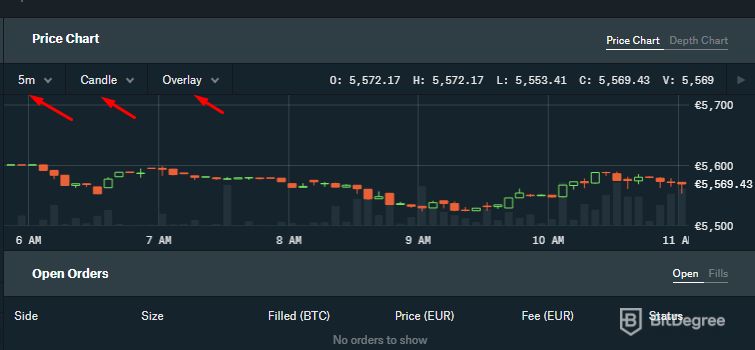
You can also change the chart from candlestick bars to lines. Take a look at the screenshot below!

Sign up on Binance and claim up to $600 worth of rewards for completing simple tasks. Use Binance referral code (49316610) to activate the offer while it's still valid!
How to Trade on GDAX
Once you have decided what trade you want to do, head over to the order form on the left of the screen. As you will see from my example below, you can choose either ‘Market Order’, ‘Limit Order’ or ‘Stop Loss Order’. If you can’t remember what these mean, go back up to the ‘Who should use GDAX?’ part of my GDAX review!

If you are going for a market order, all you need to do is enter the number of coins you want to buy or sell. If you want to do a limit or stop loss order, then enter the number of coins you want to buy or sell and the amount you want the order to be executed at.
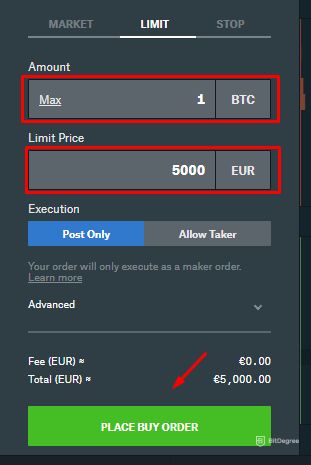
As you can see from the above example, I have done a limit order. I have specified that I want to buy 1 BTC when the price goes down to 5,000 EUR. Once I click on Place Buy Order, my trade will only be executed when the price of BTC goes down to 5,000 EUR!

- Secure and reliable
- Accepts fiat currencies
- Lots of trading options
- Reputable exchange
- Accepts fiat currencies
- Offers various trading options

- Fiat currencies - accepted
- Simple to use
- Accepts only the most trustworthy cryptocurrencies
- A leading cryptocurrency exchange platform
- Best for beginner investors
- Accepts fiat currencies

- Fully reserved and transparent
- Multiple tradable asset classes
- Over 300 supported cryptos
- Over 300 cryptocurrencies
- Secure & transparent
- Fully reserved
GDAX Review: Conclusion
And that’s the end of my GDAX review! I know I have provided you with lots of information, but if you have read it from start to finish, you will now know everything there is to know about them!
This includes everything from GDAX fees, customer support, coin availability, security, user-friendliness, and even payment methods! I also gave you some really useful screenshots of how to use GDAX for the very first time!
Ultimately, I think GDAX is one of the better exchanges in the industry. Although you can only trade four different coins, I like how easy it is to deposit and withdraw funds, and the security is great too. I also like the fact that there is plenty of liquidity!
If you want to look into other, more-recommended exchanges, you can check out Kucoin, Binance, and Kraken.
The content published on this website is not aimed to give any kind of financial, investment, trading, or any other form of advice. BitDegree.org does not endorse or suggest you to buy, sell or hold any kind of cryptocurrency. Before making financial investment decisions, do consult your financial advisor.







